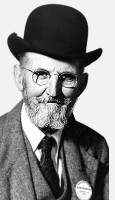Liberal University of Oregon
Silverton's Start - by June Drake
(Adapted from the Silverton Centennial Program Guide - 1954)
 Editors Note: June D. Drake was born in 1880 in Marquam, Oregon. In 1904 he married another Silverton resident, Eleanor Schoenfield. The couple had two children, Charles and Ardith. Drake was an active participant in the community, serving in several positions in city government. In 1904, June Drake and his brother, Emory, established the Drake Bros. Studio, buying out the business of William L. Jones. Emory left the partnership in 1908 and moved to Sacramento, California, to enter the music business. The same year the studio burned and many negatives were lost. June Drake built another studio in 1911, and continued to use the Drake Brothers imprint.
Editors Note: June D. Drake was born in 1880 in Marquam, Oregon. In 1904 he married another Silverton resident, Eleanor Schoenfield. The couple had two children, Charles and Ardith. Drake was an active participant in the community, serving in several positions in city government. In 1904, June Drake and his brother, Emory, established the Drake Bros. Studio, buying out the business of William L. Jones. Emory left the partnership in 1908 and moved to Sacramento, California, to enter the music business. The same year the studio burned and many negatives were lost. June Drake built another studio in 1911, and continued to use the Drake Brothers imprint.Drake's photography documenting the spectacular Silver Falls was an important element in establishing a state park, but he also created publications advertising the beauty of the area and built signs in the area. His work was instrumental in protecting the Silver Falls area from logging and convincing legislators to create a state park, on April 2, 1931. Drake's name still appears on landmarks in the area in recognition of his work. June Drake died in 1969.
Silverton dates back to 1854 when a post office named Silver Creek was established in a small store on November 16, 1854. This post office was changed to Silverton on July 16, 1855, to correspond with a platted townsite laid out by Polly Crandal Coon Price, widow of J. L. Coon, which was called Silverton.
The name Silver Creek was given to the stream which runs through Silverton by sheer accident. The records show the name Silver Creek dates back to 1846 when James Smith built a sawmill on a stream called Silver Creek. He was joined in this endevor by his son-in-law, John Barger, in 1847. This mill was located two miles southeast of where Silverton now stands. The place was later known as Milford.
Before a settlement was started at Silverton three fords were used to cross Silver Creek as there were no bridges on any of the streams in the pioneer days. Travel was a struggle in winter, and not too good in summer. One of these fords was near James St. bridge and was still in use as late as 1911 or until the first James St. bridge was built.
Another ford was back of the Drake Bros. Studio, 303 N. Water St., and the third one was at the end of Oak St. where Mac's Place now stands. This ford still is quite visible on the west bank of the stream. Many immigrant trains crossed these old fords. [Editor's Note: The Mac's Place ford can still be seen from the Back Dining Deck.]
Both T. W. Davenport, a pioneer of 1851 and father of the late Homer C. Davenport, world-famous cartoonist from Silverton, and Dr. A. F. Blackerby, a son of Dr. James Monroe Blackerby, pioneer doctor of this community, who arrived in 1848, taking up land on Drift Creek, told me several stories of these fords and I have seen the James Street crossing used many times, especially for heavy machinery such as threshing equipment, etc.
The name Silver Creek is surely applicable to the stream flowing through Silverton as its waters are like a silver ribbon flowing between wooded banks of green, and deep chasms where there are cataracts of great height that churn its waters into silver spray and multi rainbows display the spectrum colors -- violet, indigo, blue, green, yellow, orange and red--beckoning tourists to enjoy their charm and beauty before departing for the sea. This is the stream from which Silverton takes its name.
Text and image courtesy the Estell family.

